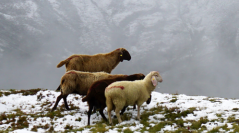

 Anthropozoologica
57 (4) - Pages 117-139
Anthropozoologica
57 (4) - Pages 117-139Sheep were vital to Alpine subsistence strategies during the Neolithic as well as the Bronze and Iron Ages. The present study deals with the question of phenotypic alterations in Alpine sheep during these 4500 years of prehistoric Alpine livestock farming. It furthermore addresses the issue of to what extent morphological developments were triggered by processes of economic, cultural or ecological change. To answer these questions, bone measurements of sheep from 59 find complexes in an Alpine model region were examined. The region stretches between the Northern Pre-Alps and the Padanian Plain and comprises the valleys of Inn, Isarco and Adige along with adjacent regions. As shown by the application of logarithmic size index analyses and withers height calculations, the phenotypic development of sheep was characterised by micro-regional differences; for example, while the Inn Valley population underwent a size reduction from the Late Bronze Age onwards, the conspecifics of the southern Alpine fringe grew synchronously larger. For other regions, no diachronic changes were observed. Based on the osteometric analysis, the following factors are discussed as potential triggers for phenotypic alterations in Alpine livestock: climatic fluctuations, a physical adaptation to high altitude pasturing, the emergence of wool farming, the introduction of allochthonous livestock in the context of cultural transfer and shifts in the sex ratios caused by changing exploitation patterns. In order to evaluate the possible influence of these aspects on sheep morphology, the osteometric results are compared to different data on the cultural and climatic development of the Alpine region.
Alps, archaeozoology, Prehistory, exploitation patterns, Logarithmic Size Index, Neolithic, Bronze Age, Iron Age.